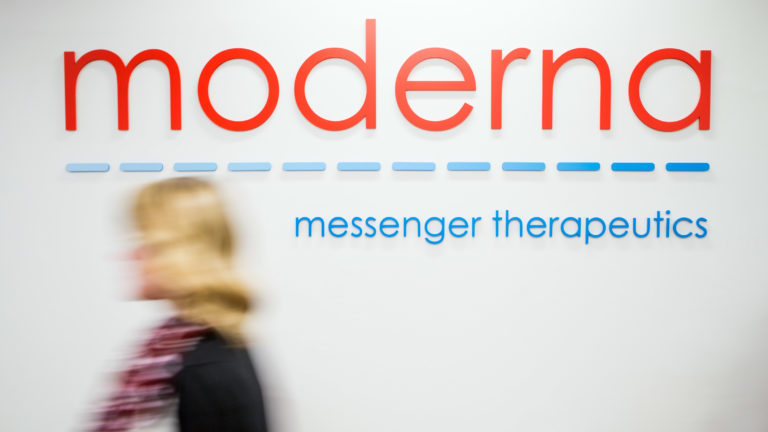By Damian Garde – Posted on Jan. 10, 2017

Moderna Therapeutics, the most highly valued private company in biotech, has run into troubling safety problems with its most ambitious therapy, STAT has learned — and is now banking on a mysterious new technology to keep afloat its brash promise of reinventing modern medicine.
Exactly one year ago, Moderna CEO Stéphane Bancel talked up his company’s “unbelievable” future before a standing-room-only crowd at the annual J.P. Morgan Healthcare Conference here. He promised that Moderna’s treatment for a rare and debilitating disease known as Crigler-Najjar syndrome, developed alongside biotech giant Alexion Pharmaceuticals, would enter human trials in 2016.
It was to be the first therapy using audacious new technology that Bancel promised would yield dozens of drugs in the coming decade.
But the Crigler-Najjar treatment has been indefinitely delayed, an Alexion spokeswoman told STAT. It never proved safe enough to test in humans, according to several former Moderna employees and collaborators who worked closely on the project. Unable to press forward with that technology, Moderna has had to focus instead on developing a handful of vaccines, turning to a less lucrative field that might not justify the company’s nearly $5 billion valuation.
“It’s all vaccines right now, and vaccines are a loss-leader,” said one former Moderna manager. “Moderna right now is a multibillion-dollar vaccines company, and I don’t see how that holds up.”
Bancel made no mention of the Crigler-Najjar drug when he spoke Monday before a similarly packed room at this year’s J.P. Morgan conference.
His presentation instead focused on four vaccines that the company is moving through the first phase of clinical trials: two target strains of influenza, a third is for Zika virus, and the fourth remains a secret. Bancel clicked through graphs of data from animal studies before hurrying on to tout Moderna’s balance sheet and discuss the company’s cancer vaccines, slated for clinical testing later this year.
When STAT asked Bancel after the presentation about Crigler-Najjar, he deferred to Alexion.
In need of a Hail Mary
Founded in 2012, Moderna reached unicorn status — a $1 billion valuation — in just two years, faster than Uber, Dropbox, and Lyft, according to CB Insights. The company’s premise: Using custom-built strands of messenger RNA, known as mRNA, it aims to turn the body’s cells into ad hoc drug factories, compelling them to produce the proteins needed to treat a wide variety of diseases.
But mRNA is a tricky technology. Several major pharmaceutical companies have tried and abandoned the idea, struggling to get mRNA into cells without triggering nasty side effects.
Bancel has repeatedly promised that Moderna’s new therapies will change the world, but the company has refused to publish any data on its mRNA vehicles, sparking skepticism from some scientists and a chiding from the editors of Nature.
The indefinite delay on the Crigler-Najjar project signals persistent and troubling safety concerns for any mRNA treatment that needs to be delivered in multiple doses, covering almost everything that isn’t a vaccine, former employees and collaborators said.
The company did disclose a new technology on Monday that it says will more safely deliver mRNA. It’s called V1GL. Last month, Bancel told Forbes about another new technology, N1GL.
But in neither case has the company provided any details. And that lack of specificity has inevitably raised questions.
Three former employees and collaborators close to the process said Moderna was always toiling away on new delivery technologies in hopes of hitting on something safer than what it had. (Even Bancel has acknowledged, in an interview with Forbes, that the delivery method used in Moderna’s first vaccines “was not very good.”)
Are N1GL and V1GL better? The company has produced no data to answer that question. When STAT asked about new technologies, Bancel referred questions to the company’s patent filings.
The three former employees and collaborators said they believe N1GL and V1GL are either very recent discoveries, just in the earliest stages of testing — or else new names slapped on technologies Moderna has owned for years.
“[The technology] would have to be a miraculous, Hail Mary sort of save for them to get to where they need to be on their timelines,” one former employee said. “Either [Bancel] is extremely confident that it’s going to work, or he’s getting kind of jittery that with a lack of progress he needs to put something out there.”
Former employees and collaborators who spoke with STAT requested anonymity because they had signed nondisclosure agreements — which the highly secretive Moderna requires even some job candidates to sign.
A STAT investigation last year found that Bancel had driven away top talent from Moderna with a culture of recrimination and a caustic work environment, including on-the-spot firings for failed experiments.

